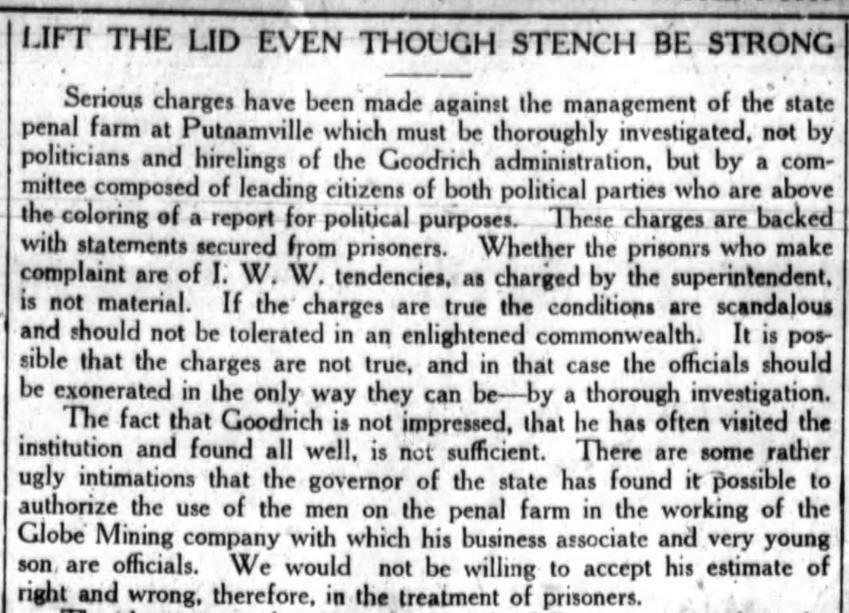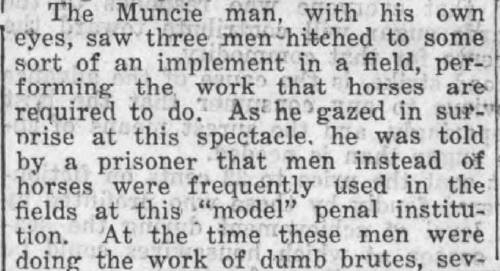While browsing through an old issue of the Madison Daily Courier (February 20, 1850), we stumbled across this eye-catching inventory from James Roberts’ store in the antebellum river town of Madison, Indiana. Two unusual items stood out: mushroom catsup and walnut catsup. What on earth was the history of these things?
In the days before H.J. Heinz, a former horseradish salesman, muscled in and mastered the art of making a pure, healthy tomato ketchup, Americans enjoyed an amazing variety of ketchups or “catsups.” Many antebellum Hoosiers could have bought these at the store. Others would have been able to make them from scratch using ingredients often available in Hoosier fields and forests.
Like many American families, the ketchup family isn’t native to the New World. Both the word and the condiment likely came from China or Malaysia, where ke-chap referred to a brine of pickled fish or shellfish. East Asian ketchups were salty or soy-based and had a liquid consistency, unlike often-stubborn tomato ketchup, a “non-Newtonian” fluid that needs a thump to get moving.
The first known mention of the word ketchup in English comes from a dictionary of slang from 1690, where it’s defined as a “high East-India sauce.” In fact, British East India traders are credited for bringing the sauce back from Asia. Word-sleuths, however, think that ketchup might have come from an Arabic word, kabees, also referring to a pickling sauce.
One Englishman, Charles Lockyer, gave advice to other traders in the Orient on how to get the best deals on lucrative soy sauce and ketchup — in 1711.
(Charles Lockyer, An Account of Trade in India, 1711.)
It’s hard to believe anyone would sail all the way to Asia and back in a wooden boat just for ketchup — or that King George and George Washington were throwing ketchup on their food. But eighteenth-century Britain and America were definitely familiar with the ketchup “family.” In fact, catsup, once thought to be an Americanized version of the word, was actually a misspelling by the Irish satirist and Anglican priest Jonathan Swift, author of Gulliver’s Travels, who used it in a comic poem in 1730.
Eliza Smith, one of the bestselling English cookbook writers, describes how to make ketchup in her book The Compleat Housewife, or, Accomplish’d Gentlewoman’s Companion. Smith died around 1732, but her cookbook came out in many editions and was the first one ever printed in the American colonies. In 1742, a year before Thomas Jefferson’s birth, the cookbook was reprinted in Williamsburg, Virginia.
Yet Smith’s recipe for “English Katchup” didn’t call for a single tomato. Instead, you needed mushrooms, anchovies and horseradish. The vinegary result tasted and looked something like Worcestershire sauce. It took a week to make.
(Eliza Smith, The Compleat Housewife, London, 1727. The book was re-printed in Williamsburg by William Parks, who ran one of the first paper mills and thus helped turn out some of the earliest American newspapers, including Benjamin Franklin’s Pennsylvania Gazette. This instructional video on 18th-century cooking will tell you how to put together a mushroom ketchup that would have been familiar to Americans almost 300 years ago.)
Ketchup’s historic association with pickling sauces and fish was still strong in the mid-1800s, when grocery stores like James Roberts’ just downstream from Cincinnati were advertising the arrival of seafood and condiments from the East Coast. Much of that food came aboard steamboats floating down from Pittsburgh — future ketchup capital of the world (but not yet…)
For generations, many Europeans and Americans were literally scared of tomatoes and tomato-loving worms, believing both to be the source of a deadly poison. Part of the reason why the tomato was once considered a “poison apple” was that wealthy Europeans ate it off pewter plates high in lead content. Botanists and cultivators slowly dispelled these myths. By the 1870s, doctors and plant-growers had sparked a craze for the tomato as a medical cure-all. Before the 1830s, though, that lingering fear of the tomato was one reason why it was slow to be accepted into the family of ketchups.
(Evansville Daily Journal, December 4, 1848. Incidentally, the cans that lobsters, fish and catsups were packed in might have caused health problems. Cans sealed with lead have been considered a possible cause of the medical disaster that led to the death of Sir John Franklin’s expedition to the Arctic in 1845, just three years before this ad came out. Post-mortem tests on 138-year-old bodies of crewmen, mummified in the Canadian permafrost, gave evidence of lead poisoning when they were exhumed, amazingly intact, in 1984.)
What were some of the other varieties of ketchup?
Walnut ketchup still occasionally makes it onto the table and usually tastes something like A-1 Steak Sauce. Charlotte Mason, a Revolutionary-era chef in England, promoted fermented varieties of walnut ketchup in The Lady’s Assistant, a cookbook published in London in 1787 and available in the U.S. You’d have to plan your dinners well in advance, though. Like distilled liquor, some fermented ketchups take several months to make. Fortunately, Charlotte Mason definitely believed in bulk cooking — and some varieties would “keep for years.”
(Charlotte Mason, The Lady’s Assistant, for Regulating & Supplying the Table, London, 1787. “Eschalot” was an old word for shallots. Harvesting green walnuts is tough due to the time-frame — a small window in late June and early July, another reason to make it in bulk.)
Just as beer- and whiskey-lovers have been rediscovering all the varieties of alcohol that Americans enjoyed before Prohibition put the nix on brewers and distillers, foodies are unearthing some of the ketchup varieties that once existed in Old American cooking.
These included concord grape ketchup (including this recipe from western New York for grape catsup applied to sweet potato fries and/or Greek yogurt) and lemon ketchup. An unusual historic recipe from 19th-century New Hampshire tells how to make cucumber ketchup. One chef touts a tangy peach ketchup calling for ingredients as diverse as cinnamon, sugar, chili, molasses and vinegar. Oyster ketchup was often made directly from oysters, but other oyster ketchups were made from tomatoes and meant to be put on oysters. Van Camp Packing Company in Indianapolis and the Loudon Packing Company in Terre Haute were once major producers of oyster ketchup.
(Recipe for a fermented version of lemon catsup, Greencastle Herald, Greencastle, Indiana, July 27, 1911.)
Since fermentation was often involved, ketchup sometimes began to be treated like wine. The Indiana Palladium in Lawrenceburg (future home of Seagram’s Distillery) reprinted a clip from an article in the United States Gazette of Philadelphia about the tomato and its use in regulating digestion. This was around the time that the health benefits of the once-misunderstood “poison apple” were finally being promoted. The author praises a “very choice bottle” of fermented tomato ketchup, bottled by his family six years earlier — in 1827.
(Indiana Palladium, Lawrenceburg, October 18, 1834. Castor was a common purgative used to open up the bowels. Ketchup, especially ketchup compounds sold as medicine, was also thought to cure both constipation and diarrhea.)
The tomato’s fortunes were on the rise. But until Henry Heinz came along, eating tomato ketchup could still put your life in jeopardy. The problem lay in poor sanitation at factories and bottling plants — and the issue of how to keep tomato ketchup red.
Writers around the time of the Civil War described the disgusting horror show that sometimes came pouring out of ketchup bottles: yeasty, moldy, bacteria-laden filth. Food poisoning and even death weren’t an uncommon fate after consumption of “putrid, decomposed” tomato ketchup. Amazingly, manufacturers — including Charles Loudon in Terre Haute — often used coal-tar dye, an ingredient in road construction, to preserve the tomato’s bright red appearance. It was only in 1882 that writers began to point out the dangers of coal tar. Aware of ketchup nightmares, Gardener’s Monthly that year encouraged American families to steer clear of industrial ketchup and keep on making their own. A further danger came from boric acid, once used as a food preservative and now used in athlete’s foot medication and insecticide.
(H.J. Heinz around the time he moved beyond the horseradish business and forever changed the ketchup industry.)
By the 1870s, Henry Heinz of Pittsburgh was sparking a revolution in the ketchup, sauerkraut, and pickle business. Heinz’s family had emigrated from Kallstadt, Bavaria, hometown of Donald Drumpf’s ancestors. Unlike many Gilded Age business moguls, Heinz was a political progressive and took great strides to improve life for workers at his plants — and to keep bacteria out of his customers’ food.
With a good knowledge of advances in chemistry and public health, by 1906 Heinz was turning out a preservative-free ketchup (i.e., no coal tar!) and used transparent jars so his customers could see exactly what they were buying. Heinz was proud of his factories: even in notoriously polluted Pittsburgh, his employees had access to showers, swimming pools, gardens, medical stations, fresh laundry, free manicures and lunchtime open-air concerts. He offered free life and health insurance to workers and free tours to the public because — like his bottles — he felt he had nothing to fear from transparency. The Heinz Company hired thousands of women, and Heinz raised their wages against the advice of his business committee. He also took out ads in women’s magazines to warn the public about the dangers of certain food preservatives.
(Women at the Heinz Factory in Pittsburgh, circa 1901.)
Knowing that quality food and happy workers meant bigger profits, the ketchup mogul was a major force behind getting the Pure Food and Drug Act passed in 1906, a year after Upton Sinclair’s The Jungle, an exposé of meatpackers, came out in a Socialist newspaper in Kansas, Appeal to Reason. (That paper’s editor, by the way, was Julius Wayland, a native Hoosier who once nearly got lynched in Versailles, Indiana, for his Socialist views.)
Heinz’s revolution — a “red” one, indeed — soon spread to the Midwest. Today, Red Gold in Elwood, Indiana, is the top ketchup producer in the U.S., beating out even Heinz. And the Hoosier State itself ranks second only to California in tomato processing. To think that it all began with a 17th-century Asian fish sauce…
(Laborers pick tomatoes for the Loudon Packing Company of Terre Haute. Loudon had hometown competition in the ketchup business from Hulman & Company — whose owner, Tony Hulman, later bought the Indianapolis Motor Speedway. By World War II, however, Loudon’s company had won minor fame itself by becoming the first major producer of V8, once made in Terre Haute.)
(Evansville cartoonist Karl Kae Knecht helped enlist tomatoes during World War II. Indiana tomato production “splatters” Hitler, Mussolini, and Emperor Hirohito, Evansville Courier, August 10, 1942.)
Contact: staylor336 [AT] gmail.com










































 Muncie Post Democrat, August 4, 1922.
Muncie Post Democrat, August 4, 1922. 





